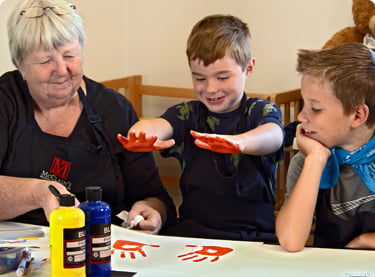Creating art in the classroom helps kids develop a love for creativity, especially when exploring the works of iconic artists like Claude Monet. Monet’s impressionist style captures the imagination and inspires creativity.
In this lesson, Barbara Mason explores the world of Claude Monet and French Impressionist art. She will explain how Claude Monet became a painter, as well as how playing with light and color led him to the beautiful art we see in museums today.
Claude Monet – French Impressionist Lesson Curriculum
The History of Claude Monet and His Art Video
Watch the art lesson video to learn about Claude Monet, his water lily paintings – and to begin your own water lily painting at home.
Materials Needed for the Claude Monet Art Lesson
- Sponge
- Poster paint
- Water
- Paper plate
- Thick paper or canvas
Scroll to the bottom to see photos of Claude Monet with his paintings and his gardens in France.
Learn About Claude Monet and French Impressionist Art
Follow along with the video transcription below as Barbara tells you about Claude Monet and French Impressionist art.
Hi, this is Barbara Mason. Welcome to Golden Road arts. You can see I still have my mask on because not everybody has been vaccinated. I fortunately got my vaccination already, but a lot of people haven’t. And so, until we know that everybody is vaccinated, we’re going to be really, really careful with our masks – but I’m going to take it off now so that I can talk to you a little easier while we’re doing our visit today.
So, we’re going to talk about an artist today named Monet and his first name was Claude, and he was a French artist, and he was born in 1840. So how long ago do you think 1840 was? Well, let’s see 1840 to 1940. That’s 100 years. Not 2040 yet. But that’s 180 years. He’s 180 years ago that he was born. So, when Claude was young, he wanted to be an artist. His mother was very supportive, but his father didn’t think he should be an artist. He thought “how can an artist make a living?” Which we know now that artists can make a living. But at the time he didn’t think that it would be a good choice for his son, and so they sent him to a regular school where he was learning other things.
And about the time he was ready to get out of school, he actually had a nervous breakdown. He was so upset about the fact that he was going to have to be a clerk rather than an artist, that he just felt terrible and so his father relented, and he said, OK, we’ll let you go to art school, and so he went to art school. And it’s a good thing he did, because we consider Claude Monet the founder of modern art.
So, one of the things that Claude Monet was really, really interested in – he was interested in light. He was interested in the way light. If you put two colors together, what happened? If you put another color together instead what happened? And so, one of the things that he did as a painter is he painted the same exact image over and over again. Different times of the day, so that each time he painted it, the light was a little different. And instead of just painting it all in a big swish, he would use some little pieces of color, so one next to the other. And if you put a light color next to a dark color or a warm color next to a cool color, it would change how things looked and it would vibrate.
And one of the things that he was very famous for is he did a lot of paintings of haystacks and a lot of paintings of water lilies. He had a couple of children and later on in his life, of course, he became very famous, and people started to buy his work. He moved to the town of Giverny in France and there were beautiful gardens there which he expanded on during his life. And he painted a lot of water lilies, and I’m in Portland, Oregon – close to Portland, Oregon – in Hillsboro and in our museum in Portland, we actually have one of Monet’s water lilies, so you could actually go to the Portland Art Museum, and you could actually see this painting in person, because he did a lot of these water lilly paintings, but they’re very famous.
So today what we’re going to do is we’re going to make a couple of paintings that are his water lilies. So, the first one we’re going to do is we’re going to do some painting with a sponge. I always like painting with a sponge – it is so much more fun than painting with a brush. So, this is poster paint. I’m just going to shake it up a little bit, so these are Dick Blick poster paints. But you could use any kind of paint. We haven’t even used this one. It’s not even open yet. Oh my gosh. How could that have happened? Just poke this thing out. It’s got a little piece of foam on the top of it. OK. So, I can’t believe we haven’t used green yet, but I guess we haven’t. So, you can imagine what water lilies would look like. You know – we think of water, well right away, we’re thinking of blue and green. Get a little more, a little blue and green and this one’s open. Just shake it up a little bit. So, you always want to shake your paint up a little bit before you open it, not after you open it, or you’ll be wearing it. So, you think of what colors they would be? Would they be blue, green, maybe a little bit of yellow? Put a little bit of yellow in here. Don’t forget to shake out on that. Maybe we’ll use a little bit of white. Maybe a little bit of purple. Oh, and here’s a different blue.
So, when Claude Monet was first painting, he had people that thought his work was just crazy and they weren’t too excited about it. But as he continued to paint, in his lifetime, people started to really like his work and they really thought it was amazing. When he was young, he did a lot of charcoal sketches and amazingly enough – his father was really surprised at this – he was able to sell them and so, he sold a lot of charcoal sketches.
OK, we got our blue. We probably need some purple here. If you were going to do water lilies, you’d probably want some purple. OK, so now we’re going to make our background for our watercolor painting, and so we’re going to use these sponges. I’m going to get these sponges a little bit wet, and so I think I’ll kind of start at the top and work down. So, I’m thinking there’s probably trees at the top. You know there is a website that you can go on if you want to –see how fun that is – look at how easy that is to paint with a sponge. So, I’m thinking there’s lots of trees that are kind of hanging down here behind Monet’s Garden. And you can go on the web and there’s a website called https://fondation-monet.com/en/and that is all the gardens at Giverny, France, where Monet spent the last maybe 20 years of his life with his family.
He started to really sell his work well when he got to Giverny and so money wasn’t such an issue for him and so he started – let’s make some of these darker, we’ll put a little blue in it. So, he started really being able to expand the gardens because he had quite a bit of money and he laid out, for his gardeners, exactly what he wanted, and how he wanted it to look and…
We’ll put a little bit of blue in it – and they’ve used some of those plans all the way until today. A lot of people wanted to see the gardens when Monet was alive, and they would go to France – did I put the white out? I guess I forgot about the white – and they would go to France and go and visit Monet and see his gardens. So, this is, you know, we’re over 100 years ago, Monet died in 1924 and so, they wanted to go to Giverny and see his gardens and so, in 1977, I think it was, his son – who now at this time is pretty old – his son decided to give the gardens at Giverny to France, and so they started a foundation called the Monet Foundation.
Let’s get some white in here, for these water lilies, for the water part of this. And so, they started a foundation and now you can go to France if you want to go to Giverny – it’s north of Paris, about maybe 100 – 150 miles heading kind of north, northwest of Paris and you can go to Giverny, and you can see his gardens with his beautiful, beautiful plants.
OK, so now we’re doing a little blue to make it look like water. A lot of fun, isn’t it? I love painting with a sponge – it is so much fun. You know a few times in my life I’ve had to do murals for projects for different organizations. And if you have to do a great big mural, that’s you know, say it’s as big as this wall behind me and you have to put a lot of paint on it, one of the easiest ways to get that paint on there is to use a sponge because it’s a lot of paint.
Now we’re getting more water here – this is looking pretty good, I’m liking this. Now, I’m thinking there’s probably trees at the top. Kind of hanging over the water. So now what we’re going to do is we’re just going to let this one dry. And we’re going to come back to it in a few minutes.
(Barbara will complete this painting in part two).
Get Free Online Art Lessons With Golden Road Arts
Be sure to watch the Claude Monet Part 2 art lesson, where Barbara will demonstrate more French Impressionist art techniques.
Golden Road Arts is a 501(c)(3) non-profit organization. If you enjoy these free art lessons, you can help provide more by making a donation or purchasing something from our online art gallery.











